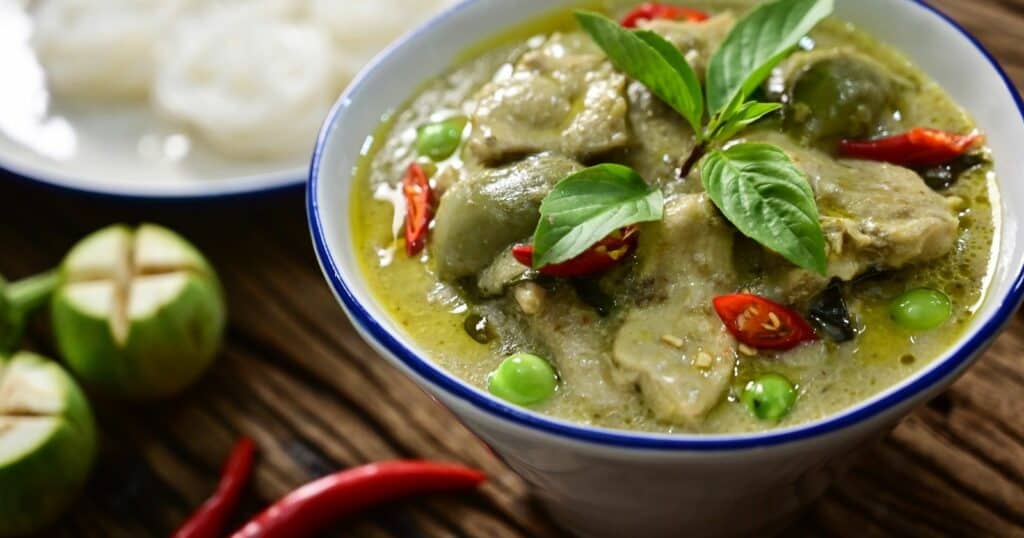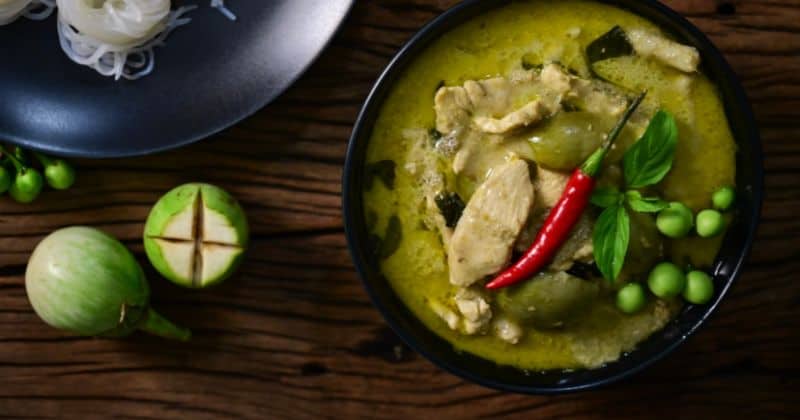For fans of Thai cuisine, green curry is a mouthwatering staple. But many wonder – is green curry spicy?
The short answer: Green curry is moderate spicy when comparing to other curry dishes in Thailand, but still have a packs of fire with green chilies. So if you can’t eat spicy food, just ignore chili in green curry and you will be fine.
Below we’ll explore what makes green curry tick, how it compares to other Thai curries, and tips for enjoying its fiery flavor. Read on to become a green curry expert!
What Is Green Curry?

Green curry (gaeng keow wan) is a classic Thai dish featuring a vibrant green sauce.
The sauce starts with a paste of fresh green chilies, garlic, shallots, lemongrass, cilantro, and makrut lime leaves. This gets simmered in coconut milk along with meat or veggies.
Common proteins are chicken, beef, pork, shrimp, fish, or tofu. Thai eggplant, bamboo shoots, peppers, and basil also make frequent appearances.
The result is a colorful, ultra-aromatic curry that perfectly balances rich, creamy coconut with the freshness of Thai herbs. A splash of fish sauce adds depth.
But it’s the fresh green chilies that give green curry its trademark spicy kick. This is what sets it apart from other Thai curries.
How Spicy is Green Curry?
So just how fiery is green curry’s burn? moderate spicy!
On a scale of 1 to 10, most versions of green curry rate between a 5 and 7 for heat levels.
It’s considered one of the moderate curries in Thai cuisine, alongside jungle curry.
However, The copious fresh green chilies used in the paste are responsible for the searing spiciness. Common peppers include bird’s eye chilies, prik chee far, and prik kee noo.
These small but super-hot chilies pack up to 100,000 Scoville heat units! For context, a jalapeño ranges from 2,500 to 10,000 SHU.
When simmered into the curry sauce, these Thai chilies release all their spicy fire. Just a spoonful lights up your whole mouth with heat.
The intensity varies between regions. Some tame it down for Western palates. But traditionally, green curry is gusty enough to make you sweat!
Green vs. Red Curry: Which Is Hotter?
Many assume that red curry must be the spiciest Thai curry thanks to its fiery hue. But that honor actually goes to green curry!
Red curry paste also contains a hefty dose of dried red chilies. However, green’s abundance of ultra-hot fresh chilies gives it an even more intense burn.
Here’s a quick heat comparison:
- Green curry – Moderately spicy, using lots of fresh green chilies. Lingering heat that builds.
- Red curry – Very spicy, using dried red chilies. More power than green.
Ranking Thai Curries by Spice Level
All Thai curries pack some heat, but they vary in their spice levels. Here’s how the main players stack up from mildest to wildest:
Mild
- Massaman curry – Uses spices like cinnamon and cloves for warmth, not chilies. Gentle heat.
- Yellow curry – Gets color from turmeric and only moderate chili heat.
Medium
- Panang curry – Peanutty and rich-tasting. Not too hot.
- Jungle curry – No coconut milk cuts the chilies’ fire.
- Green curry – Fresh green chilies make it very spicy and pungent.
Hot
- Red curry – Dried red chilies bring a mellow but lingering burn.
Extremely Hot
- Southern Thai curry – Blisteringly spicy thanks to lots of bird’s eye chilies.
- Phrik khing curry – “Phrik khing” translates to “hot green” for good reason!
Clearly green curry has some seriously spicy company at the top. But it still reigns supreme for its fresh, fiery flavor.
Taming Green Curry’s Heat
For those who find green curry’s spice level incendiary, there are some tricks to tame the heat.
- Add extra coconut milk – The creamy, fatty coconut milk helps counterbalance the burn.
- Use less curry paste – Green curry gets its kick from the paste, so use less to temper the heat.
- Skip the chili seeds – Much of the heat comes from the seeds, so seed your chilies.
- Pick a milder protein – Delicate tofu and vegetables feel spicier than chicken or beef.
- Stay hydrated – Drink plenty of water and cool beverages to soothe your tastebuds.
- Add starchy rice – A bowl of rice absorbs some of the chili heat.
- Top with yogurt – Cool, tangy yogurt or raita provides relief.
With a few tweaks, you can adjust a fiery green curry to be as spicy as your tastebuds can handle.
How To Make Green Curry Paste
To get familiar with green curry’s spice level, try making your own paste!
Here’s an easy homemade green curry paste recipe to experiment with:
Ingredients:
- 8-10 green chilies, chopped
- 1 tablespoon lemongrass
- 3 shallots, chopped
- 3 garlic cloves
- 2-3 coriander roots
- 1 tablespoon grated ginger
- 1 tablespoon lime zest
- 2 kaffir lime leaves
- 1 bunch cilantro, chopped
- 1 teaspoon salt
- 1 teaspoon shrimp paste
Instructions:
- In a food processor, blend all ingredients into a smooth paste.
- Add a splash of water if needed for blending.
- Use immediately or store in the refrigerator up to one week.
Start with fewer chilies for a milder curry paste. Add more for extra heat. Adjust to your desired spice level.
Frequently Asked Questions
Still wondering just how hot you can handle green curry? Here are some common questions answered:
Which is hotter, green curry or vindaloo?
Vindaloo is hotter. This intense Indian curry gets its spice from dried red chilies, garlic, ginger, and vinegar.
Can you make green curry without the coconut milk?
Yes, it’s called “jungle curry.” Without the cooling coconut milk, the spicy heat intensifies.
What’s a good meat for milder green curry?
Chicken, beef, and pork hold up well to spice. Delicate shrimp and fish will taste hottest.
Does the green color affect the heat?
No, the color just comes from the green chili peppers and herbs. It’s not linked to spiciness.
Enjoy Green Curry’s Fiery Fun
With its fresh chili spice and zesty Thai flavors, green curry is an amazing (and tongue-tingling) experience for heat seekers. Arm yourself with milk and rice to tame the flames.
For more mild but still flavorful curries, go for a massaman or yellow curry next time. But the true Thai curry lover embraces green curry in all its blistering glory.
The next time you spot green curry on a Thai menu or grocery store shelf, know what its vibrant color signals: an addictively spicy ride for your tastebuds!





